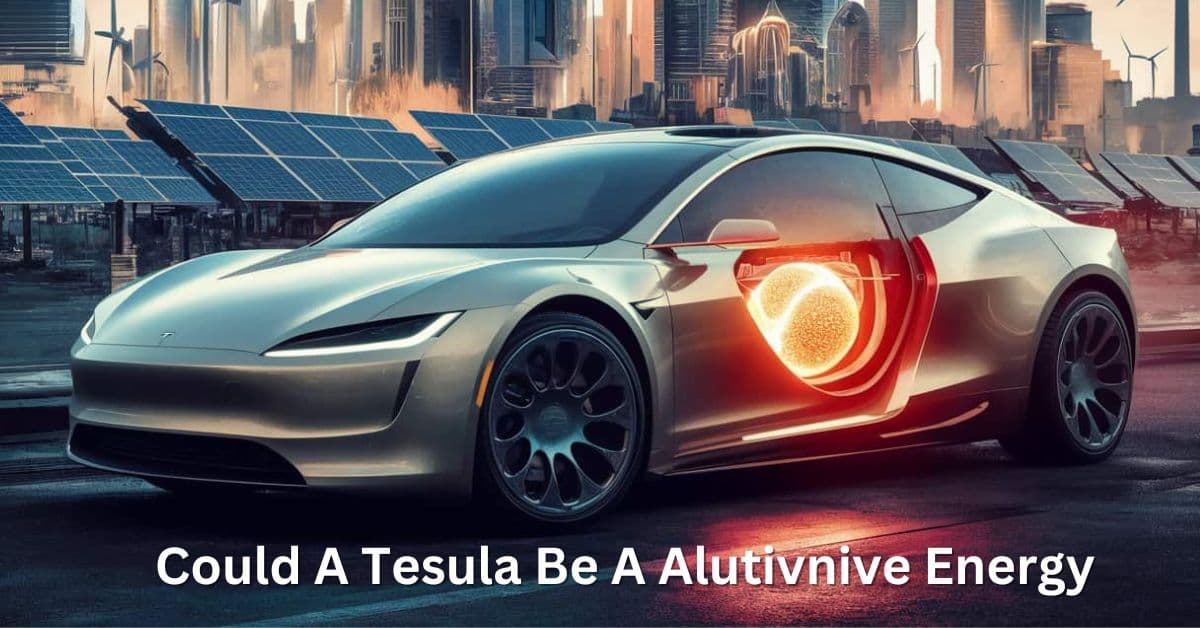After using Tesla’s solar panels and electric vehicle, I’ve been wondering, “could a tesula be a alutivnive energy My experience with these technologies shows how they contribute to sustainable energy, though they’re not energy sources themselves.
The term could a tesula be a alutivnive energy refers to whether Tesla’s technology, like electric vehicles and solar solutions, can be considered alternative energy sources. While Tesla’s products are not energy sources themselves, they significantly support and enhance sustainable energy practices.
Stay tuned as we explore the question: could a tesula be a alutivnive energy” We’ll discuss how Tesla’s innovations in electric vehicles and solar technology impact the future of sustainable energy. Don’t miss out on this insightful discussion!
What Is Alternative Energy?
Alternative energy refers to power sources that do not rely on fossil fuels. These include solar, wind, geothermal, hydroelectric, and nuclear power. The primary characteristic of alternative energy is its potential for sustainability and reduced environmental impact compared to conventional energy sources.
As the world moves toward greener solutions, understanding what constitutes alternative energy is crucial for evaluating Tesla’s role in this transformation. Additionally, alternative energy sources often provide long-term economic benefits and enhance energy security by reducing dependency on imported fuels.
Key Characteristics Of Alternative Energy:
- Sustainability: Renewable resources like solar and wind are naturally replenished, ensuring a long-term supply.
- Reduced Environmental Impact: These sources produce minimal greenhouse gases and other pollutants.
- Energy Efficiency: Advances in technology have increased the efficiency of capturing and utilizing these energy sources.
- Economic Benefits: Many alternative energy sources create jobs and can lower energy costs over time.
- Energy Independence: Utilizing local renewable resources can reduce reliance on imported fuels and enhance energy security.
Tesla’s Vision For Sustainable Energy:
Tesla’s vision for sustainable energy centers around accelerating the transition from fossil fuels to renewable energy sources. This forward-thinking approach is embodied in several key areas:
Electric Vehicles (EVs):
Tesla’s electric vehicles are at the heart of its sustainability mission. By providing high-performance alternatives to gasoline-powered cars, Tesla aims to reduce greenhouse gas emissions and decrease the reliance on fossil fuels. The company’s expanding lineup of EVs, including models like the Model S, Model 3, Model X, and Model Y, demonstrates a commitment to making electric transportation accessible and practical for consumers worldwide.
Energy Storage Solutions:
Tesla’s energy storage products, such as the Powerwall, Powerpack, and Megapack, are designed to store energy from renewable sources for later use. These systems enhance energy reliability and independence by allowing homes and businesses to store excess solar or wind energy. This capability helps balance energy supply and demand, supports grid stability, and facilitates the broader adoption of renewable energy.
Solar Technology:
Tesla’s solar initiatives include the Solar Roof and traditional solar panels. The Solar Roof integrates photovoltaic cells directly into roofing materials, providing an aesthetically pleasing and efficient way to capture solar energy. Traditional solar panels continue to be a key component of Tesla’s strategy to harness solar power for residential and commercial applications. Both technologies contribute to reducing reliance on conventional energy sources and support the transition to cleaner energy.
Sustainable Manufacturing Practices:
Tesla is also focused on reducing the environmental impact of its manufacturing processes. The company has made significant investments in its Gigafactories to produce batteries and EVs more sustainably. These facilities aim to minimize waste, lower energy consumption, and use renewable energy sources to power their operations.
Innovation and R&D:
Continual research and development are central to Tesla’s strategy. The company invests heavily in developing new technologies and improving existing ones to advance energy efficiency and sustainability. Innovations in battery technology, energy storage, and vehicle performance are all part of Tesla’s commitment to leading the transition to a more sustainable energy future.
Tesla’s Technological Advancements:
Tesla is renowned for its groundbreaking technological innovations that are reshaping the automotive and energy industries. Here are some of the key advancements:
Electric Powertrain Technology:
- High-performance electric motors that deliver exceptional acceleration and efficiency.
- Advanced battery systems with improved range, durability, and charging speed.
Autopilot and Full Self-Driving (FSD):
- Semi-autonomous driving features that assist with lane-keeping, adaptive cruise control, and parking.
- Full Self-Driving capabilities aimed at achieving fully autonomous driving through ongoing software updates and AI advancements.
Battery Technology:
- Development of next-generation battery cells with higher energy density and faster charging times.
- Innovations in battery recycling and sustainability to minimize environmental impact.
Energy Storage Solutions:
- Powerwall: A home battery system that stores solar energy for use during power outages or peak demand periods.
- Powerpack and Megapack: Scalable energy storage solutions for commercial and utility-scale applications, optimizing energy management and grid stability.
Solar Technology:
- Solar Roof: Integrated solar tiles that replace traditional roofing materials while generating electricity from sunlight.
- Solar Panels: High-efficiency panels designed to capture and convert solar energy for residential and commercial use.
Could A Tesula Be A Alutivnive Energy Source?
To determine if Tesla could be considered an alternative energy source, we need to clarify what constitutes an “energy source.” Typically, energy sources refer to materials or technologies that directly generate power. Tesla’s products, while integral to the sustainable energy ecosystem, function more as components of a broader energy solution rather than standalone sources of energy.
Integration of Renewable Energy:
- Electric Vehicles (EVs): Tesla’s EVs help reduce reliance on fossil fuels by providing a cleaner transportation alternative. Their use of electricity, which can be sourced from renewables, aligns with broader sustainability goals.
- Energy Storage Solutions: Tesla’s Powerwall, Powerpack, and Megapack store energy from renewable sources, such as solar and wind, ensuring a reliable and consistent supply of clean energy even when production fluctuates.
- Solar Technology: Tesla’s Solar Roof and solar panels capture sunlight and convert it into electricity, enabling homes and businesses to generate and utilize their own renewable energy, thereby reducing dependence on the grid.
Innovation and Development:
- Advancements in Battery Technology: Tesla’s ongoing research into battery technology aims to enhance energy storage capacity, increase efficiency, and reduce costs, making renewable energy solutions more practical and widespread.
- Autonomous Driving Technology: Tesla’s development of autonomous driving features and smart energy management systems integrates cutting-edge technology with renewable energy, optimizing energy use and paving the way for smarter, more efficient energy consumption.
- Sustainable Manufacturing Practices: Tesla’s Gigafactories are designed to produce batteries and vehicles with minimal environmental impact, utilizing renewable energy sources and promoting energy efficiency in manufacturing processes.
Global Impact:
- Expansion of Charging Infrastructure: Tesla’s Supercharger network supports the widespread adoption of electric vehicles by providing fast and convenient charging options, facilitating the transition to cleaner transportation on a global scale.
- International Projects and Partnerships: Tesla’s efforts to establish partnerships and projects worldwide help spread the benefits of renewable energy and electric mobility, fostering global collaboration towards a sustainable energy future.
What Are Tesla’s Future Prospects And Innovations?
Looking ahead, Tesla’s future prospects and innovations aim to further revolutionize the energy and automotive sectors. could a tesula be a alutivnive energy While Tesla’s technologies currently support renewable energy, future advancements may make them even more integral to sustainable energy solutions.
Tesla is working on improving battery technology for greater efficiency and longer life, expanding its network of Superchargers, and enhancing solar and energy storage systems. These innovations could significantly impact how we use and manage alternative energy in the future, aligning with the goal of reducing our reliance on fossil fuels.
FAQs:
What Makes Tesla’s Electric Vehicles Different From Other Evs?
Tesla’s electric vehicles are distinguished by their long-range capabilities, advanced autonomous driving features, and extensive supercharging network.
How Do Tesla’s Energy Storage Solutions Work?
Tesla’s energy storage solutions, such as the Powerwall, store excess energy generated from renewable sources like solar panels, providing a reliable power supply when needed.
Can Tesla’s Solar Panels Generate Enough Energy To Power A Home?
Yes, Tesla’s solar panels are designed to generate sufficient energy to meet the needs of an average home, depending on factors like location and panel efficiency.
Is Tesla Involved In Any Other Forms Of Renewable Energy?
Besides solar energy and electric vehicles, Tesla is also exploring advancements in battery technology and grid integration to support renewable energy use.
How Does Tesla’s Approach To Energy Differ From Other Companies?
Tesla’s approach integrates multiple aspects of renewable energy—electric vehicles, energy storage, and solar technology—into a cohesive strategy aimed at accelerating the transition to sustainable energy.
What Are The Benefits Of Using Tesla’s Powerwall?
The Powerwall offers benefits such as energy storage during peak hours, backup power during outages, and the ability to maximize the use of renewable energy generated at home.
Are There Any Limitations To Tesla’s Energy Solutions?
While Tesla’s products are highly advanced, limitations may include the initial cost, geographical constraints for solar energy, and reliance on battery technology.
Conclusion:
could a tesula be a alutivnive energy While Tesla’s technologies, such as electric vehicles and solar panels, are not energy sources themselves, they play a crucial role in supporting and enhancing the use of renewable energy.
By improving energy efficiency and integrating sustainable solutions, Tesla significantly contributes to the broader goal of reducing reliance on fossil fuels. Their innovations help make alternative energy more accessible and practical for everyday use.



